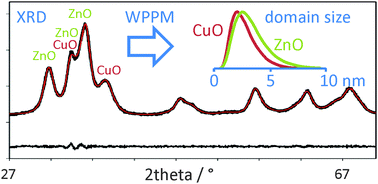Microstructure analysis of complex CuO/ZnO@carbon adsorbers: what are the limits of powder diffraction methods?†
Abstract
Activate carbon impregnated with a mixture of copper oxide and zinc oxide performs well as active adsorber for NO2 removal in automotive cabin air filters. The oxide-loaded activated carbon exhibits superior long-term stability in comparison to pure activated carbon as has been shown in previous studies. The carbon material was loaded only with 2.5 wt% of each metal oxide. Characterization of the oxide nanoparticles within the pores of the activated carbon is difficult because of the rather low concentration of the oxides. Therefore, a systematic study was performed to evaluate the limits of line profile analysis of X-ray powder diffraction patterns. The method allows evaluation of crystalline domain size distributions, crystal defect concentrations and twinning probabilities of nanoscopic materials. Here, the analysis is hampered by the presence of several phases including more or less amorphous carbon. By using physical mixtures of defined copper oxide and zinc oxide particles with activated carbon, potential errors and limits could be identified. The contribution of the activated carbon to the scattering curve was modeled with a convolution of an exponential decay curve, a Chebyshev polynomial, and two Lorentzian peaks. With this approach, domain size distributions can be calculated that are shifted only by about 0.5–1.0 nm for very low loadings (≤4 wt%). Oxide loadings of 4 wt% and 5 wt% allow very reliable analyses from diffraction patterns measured in Bragg–Brentano and Debye–Scherrer geometry, respectively. For the real adsorber material, mean domain sizes have been calculated to be 2.8 nm and 2.4 nm before and after the NO2 removal tests.


 Please wait while we load your content...
Please wait while we load your content...